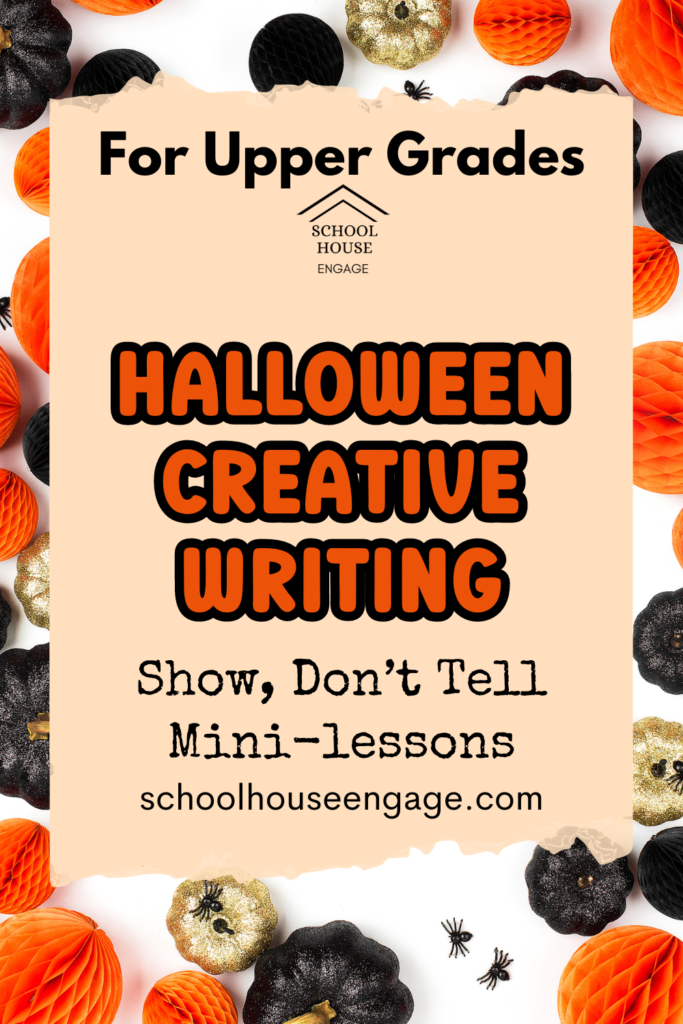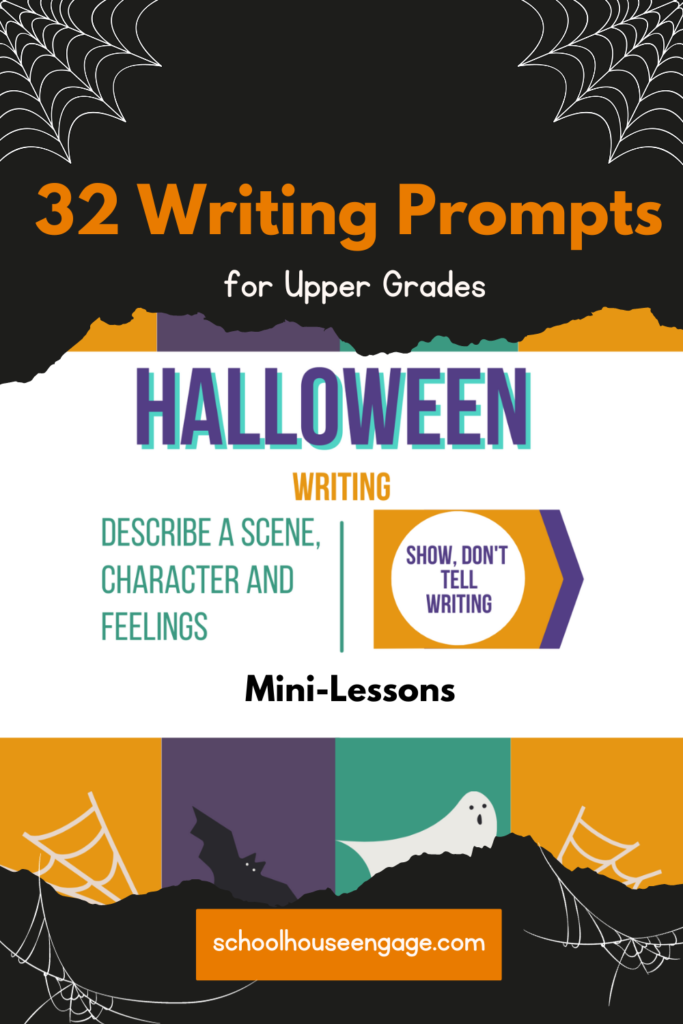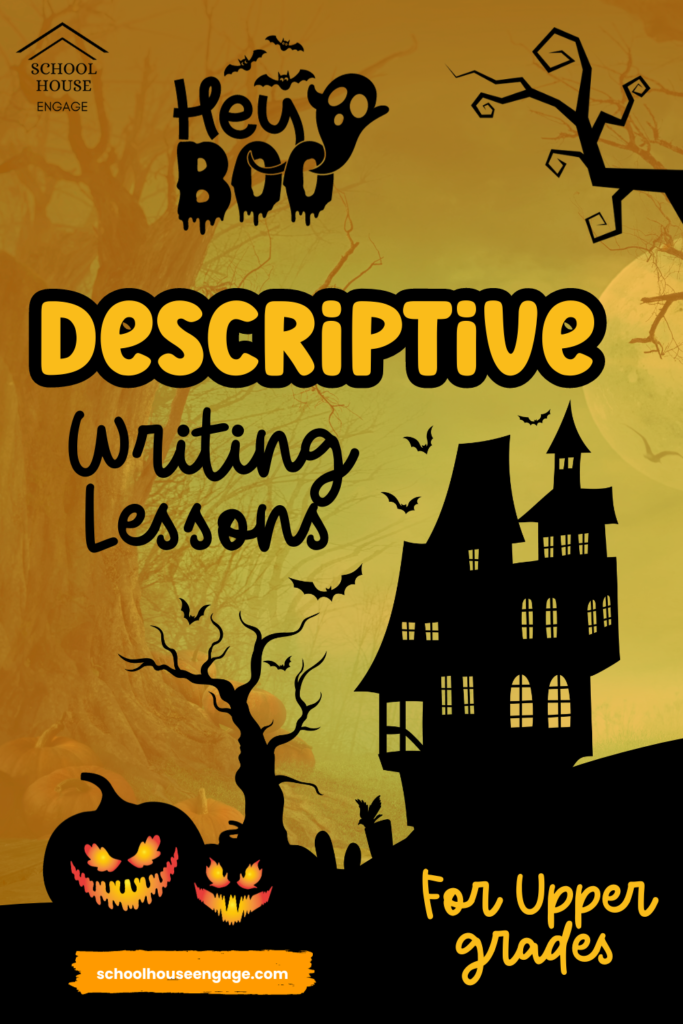Halloween is a perfect time to work on narrative writing. Students love writing spooky stories and the character ideas are endless with witches, goblins, monsters, etc.
How to Use Halloween to Teach Descriptive Writing
I use Halloween theme writing as a perfect opportunity to teach how to add more details to stories or narratives. The engagement is very high during these writing lessons, and students actually want to apply what you are teaching.
There are many ways to teach students how to add details to their writing, but I try to keep it simple by teaching them how to describe 3 things:
- scene
- character
- feelings

Describe a Scene
With all writing lessons, I follow the I do, We do, You do format.
I DO
When I teach students to describe a scene, I start with describing a cemetery.
Instead of the cemetery being spooky, we talk together as a class about how to better describe it by using the four senses (not five, because you can’t taste a cemetery, obviously!).
I ask them 2 simple questions to describe the scene:
What do you see, hear, smell or feel?
What are people, animals, or other things doing?
Then I present a paragraph that I previously wrote to describe the cemetery. I ask students to tell me how I used the senses and how I described what others were doing.
Why do I show them an example first? In the past, I’ve had students give me responses that were just too simple or vague. So I like to first show them an example of how to describe the cemetery. The example I show them is at a high level written by me.
If you want to make this lesson even easier and have examples already done for you, then you may want to purchase the lesson pack I’ve created. It includes Google Slides and printable worksheets to teach all the mini-lessons.

I am a firm believer that students should see an example of excellent writing to push kids forward. They will rise to the occasion and produce similar writing pieces when given an example of what is expected. Then we are off to the next step, which is We Do.
WE DO
In this guided practice, we write another example of how the cemetery was spooky. I ask them again:
What do you see, hear, smell or feel at a cemetery?
What are people, animals, or other things doing?
Students talk to their partner or group to get ideas, and then write a response down on paper one question at a time. That way everyone is doing actual writing! From there, I ask volunteers to read what they wrote and I type their responses.
We revised the paragraph together so it makes sense and viola, we added details!
This shared writing experience lowers any anxiety a student might have about completing the assignment because they have an example of what to do.
Sometimes I write the paragraph on chart paper but I find that students can see better when I’m typing a document on my vision board. Plus I can highlight words quickly and color code parts.

YOU DO
Now students are ready to apply what they learned. They:
- describe a haunted house in writing
- share writing with a partner
- volunteers read their writing out-loud to the class.
The next day students choose from a list of Halloween Scenes, and write a few paragraphs while I display the questions:
What do you see, hear, smell or feel?
What are people, animals, or other things doing?
The next lesson is to describe a character. I teach this skill using the aforementioned “I do, We do, You do” teaching format. Instead of the zombie was scary, we look at a paragraph that described the zombie in a “Show, Not Tell” manner.
Then we do share-writing to describe the zombie again using the following guidelines:
Describe a Character
- Describe facial expressions
- Describe clothes and accessories
- Describe how a character moves
- Use figurative language
Again, I let the students pick from a list of Halloween character prompts to describe on their own independently.
The last Show, Don’t Tell lesson is describing how you feel. This is a great exercise because students usually limit how they feel to one or two words and rarely elaborate. We follow these guidelines to describe feelings.

Describe feelings
- Show feelings through action
- Describe facial expressions
- Describe hand motions
- Explain your thoughts
- Include dialogue
- Use figurative language
The list has 6 different ways to describe feeling. This can be overwhelming for some students, so just have your struggling writers pick 3.
After all these mini-lessons, students are ready to write their own Halloween narrative story. I print put all the guidelines to describe a scene, characters, and feelings that are included in my lesson, which you can purchase HERE.
Before I let my students loose, I do have a few guidelines for them.
- No gore, blood, or weapons should be mentioned
- Nothing too scary
I don’t go into details as to what students shouldn’t write about but I make sure to keep a close watch during the writing process so nothing is inappropriate.
While they write, I walk around and read my students’ essays. You don’t want a student to invest time writing just so they have to redo it.
In all my years of teaching, I’ve never had any problems with students writing anything too scary since I always give them strict guidelines beforehand. Nor have I had parent complaints.
To make it more fun, we turn our narrative assignments into a writing contest. Once they have completed writing their narrative, I choose the top 5 essays and students take turns reading them to the class.
Any students who are extremely timid, can opt out of this oral reading and I will read their story for them. I do encourage my students to read out loud because presenting is a lifelong skill. But I do give my stage fright kiddos some grace.
When students are reading their essays in front of the classroom, it’s important to have their essays presented on a Visual Board or on a document camera so the other students can follow along. If not, some of your students can tune out without having that visual cue.
After all five students have read the essays, my class votes. I award the top three with some classroom money or any treat I may have.
All the lessons on describing a scene, character, and feelings take about a week. The following week is devoted to writing their narrative essay.
Some students will need a week and a half to write it. I teach 5th grade and I expect my students to write a five paragraph essay with about 20 sentences in total.
I hope these Halloween descriptive writing ideas help your students with creativity and higher level thinking. If you are looking for Halloween descriptive writing prompts with Show, Don’t Tell mini-lessons, please check out my TPT store. You got this! Giselle
